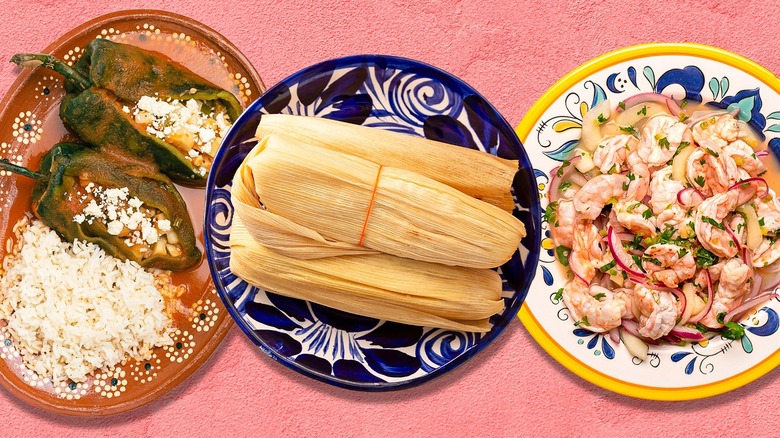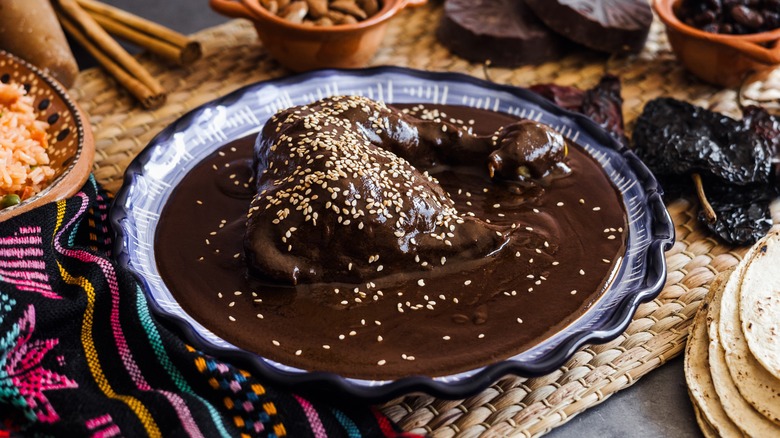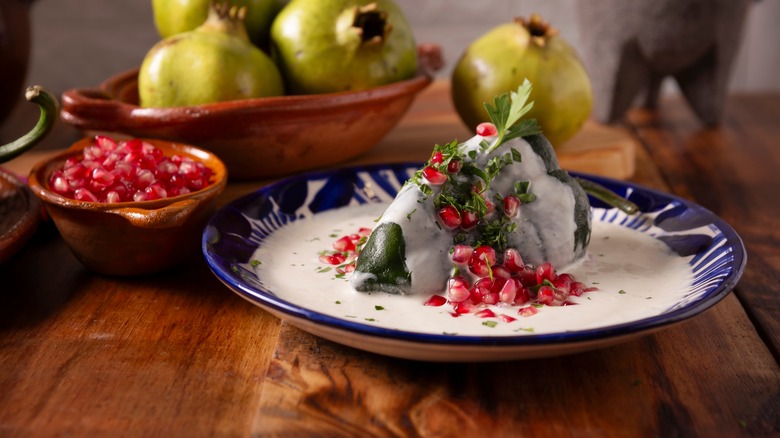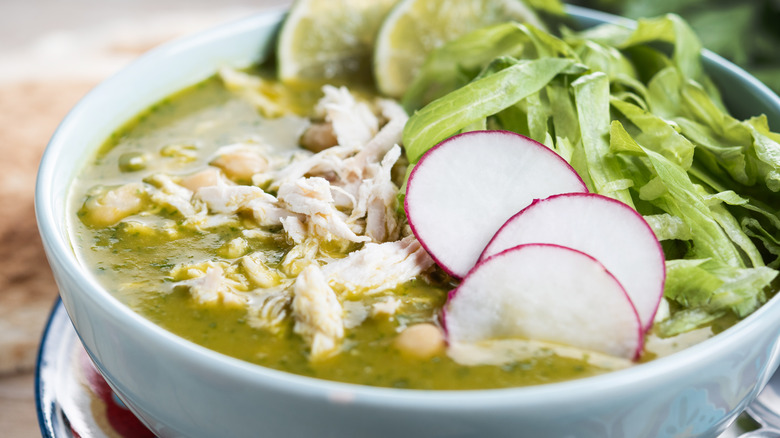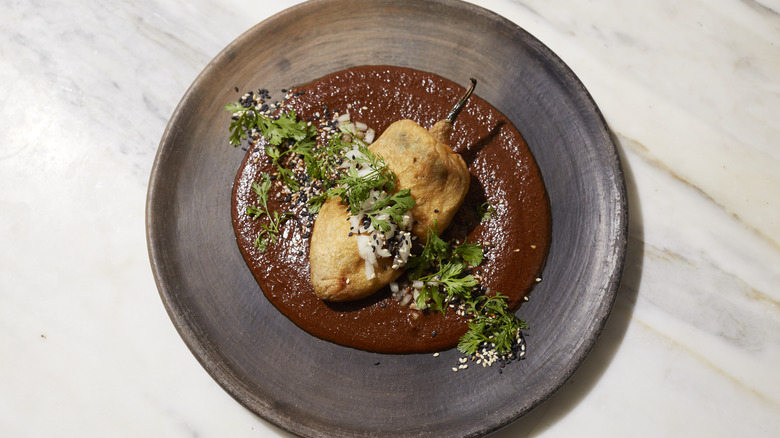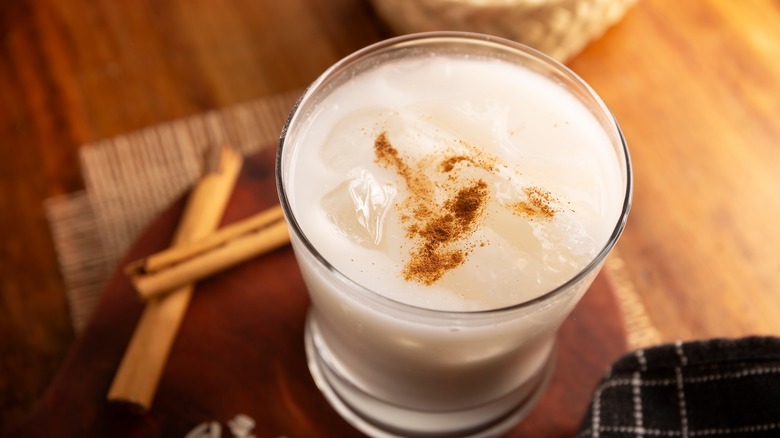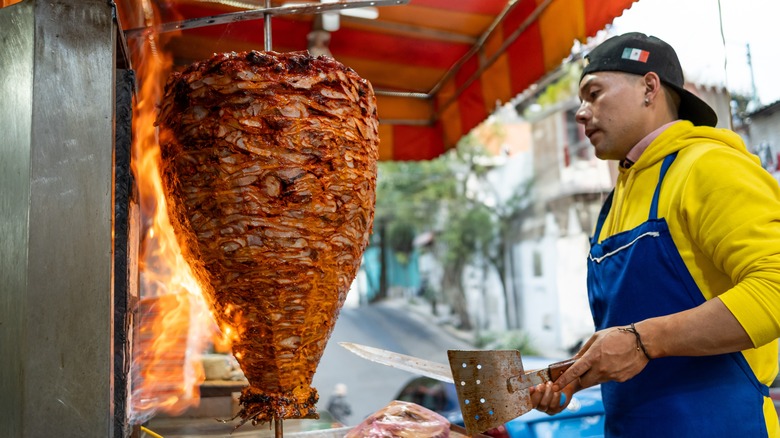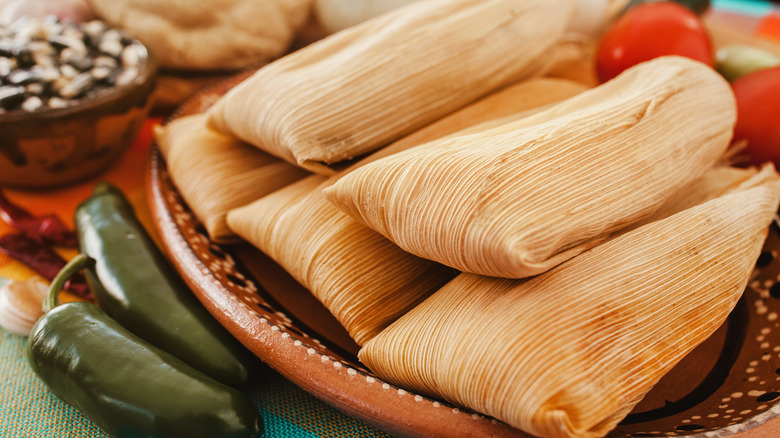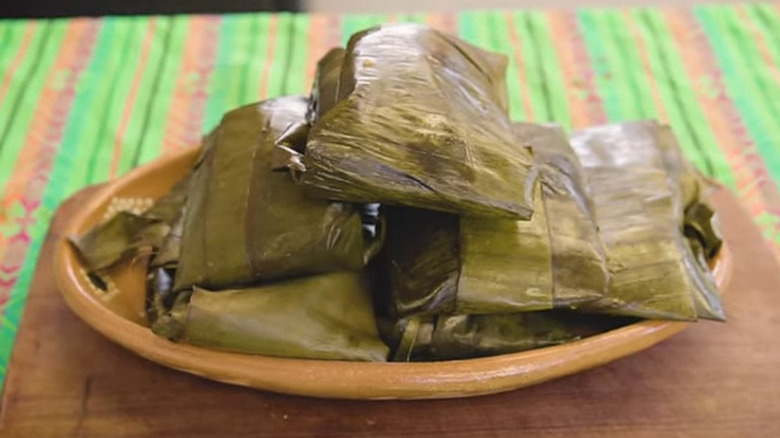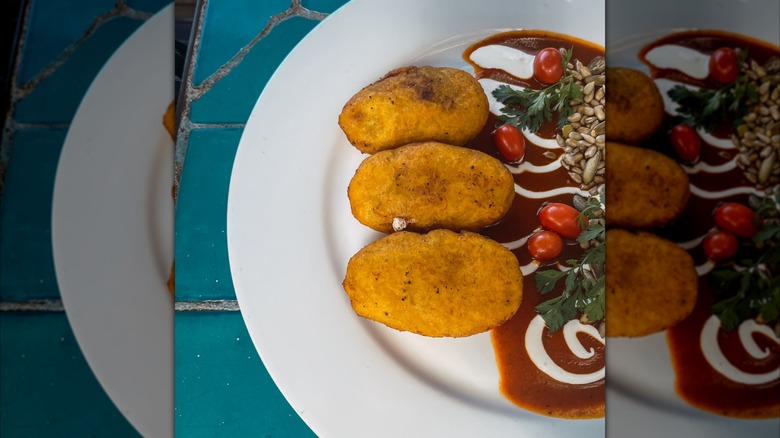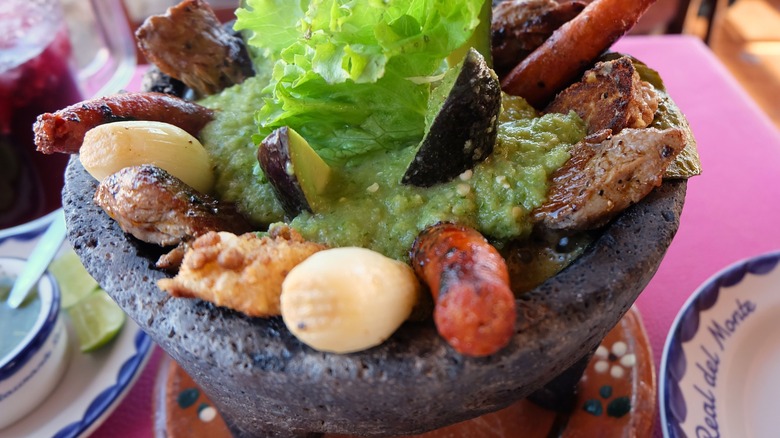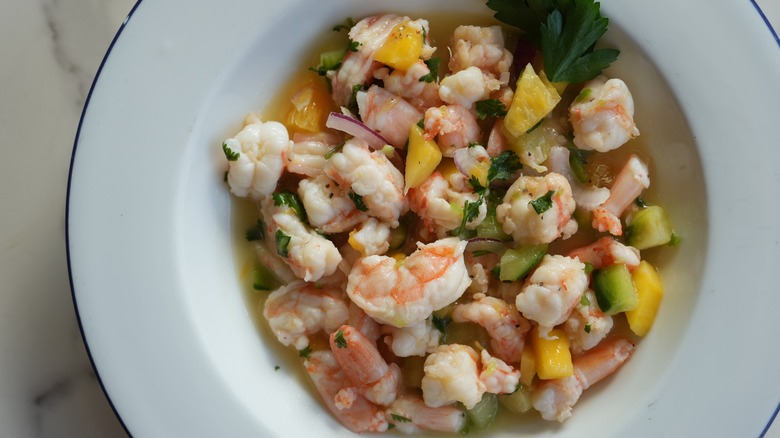13 Complicated Mexican Dishes That Aren't Worth Making At Home, According To Chefs
Most home cooks have a handful of Mexican dishes in their back pockets, ready to scrounge up at a moment's notice, when anyone mentions a hankering for Mexican fare. Maybe you make a mean fajita. Perhaps your carnitas are spectacular, or you've perfected your chimichangas over the years. Dishes like these are well within the reach of the average home cook, even if you have to fine-tune or practice a bit.
However, just as with every cuisine, Mexican cuisine has its more complicated dishes that aren't worth your time as a home cook. Whether that's due to the expert skills necessary to really pull them off, the amount of difficult-to-source ingredients required for true authenticity, or simply the time investment needed, there are things to know before standing over a hot stove for hours. And who better to help you decide which Mexican dishes you shouldn't even attempt than a group of chefs and culinary professionals who have more than their fair share of expertise in the world of all things Mexican eats? Here's what we learned when we asked nine pros for their opinions on the matter.
Mole
Across the board, numerous professionals told us that mole is just, hands down, not worth it for the average home cook. Chef Justin Mosel, director of culinary at Rubio's Coastal Grill, said that the best moles require a long cooking time and anywhere from 15 to 30 ingredients, making for an expensive cooking project with a large margin of error. Chef Nayomie Mendoza of Cuernavacas Grill also noted that spending hours at home to prepare a mole would not yield a result that matches the depth of flavor derived from professional technique.
Of course, there are many different types of mole, so not all are equal in their complexity. Chef Jorge Alejandro González Hurtado, the executive chef at Numu Boutique Hotel in San Miguel de Allende, said to steer clear of mole poblano, as the recipe is labor-intensive, requiring a multi-step process to strike the correct balance of spicy and sweet. Meanwhile, Chef Ricardo Kaufmann, Chef de Partie at Mezcal at Montage Los Cabos, cautioned home cooks to stay away from mole negro, due to the necessary ingredients that are difficult to find in the average grocery store or even outside of Mexico altogether.
Chiles en Nogada
Chiles en nogada is the national dish of Mexico, but this classic dish is not one that you'll want to try on your own, particularly if your experience cooking Mexican cuisine thus far has been limited to weeknight meals that require any sort of kit. The dish, which shows off the red, white, and green of the Mexican flag, was created by nuns in the early 1800s to celebrate Mexican independence.
Chef Hurtado calls the dish "famously elaborate," in part because you need to patiently and precisely prepare the dish's various ingredients by hand, before combining them. The process involves chopping a variety of produce and nuts, cooking a filling, letting it cool, broiling poblano peppers, peeling and deseeding them, stuffing the peppers, and making a walnut sauce. It all adds up to a potentially multi-hour endeavor. However, that doesn't stop restaurants from serving it, with professional chefs at the helm, particularly in the late summer/early fall, when the poblano chiles are ripe.
Pozole
Another dish that Chef Hurtado warns inexperienced home cooks away from? Pozole. However, he clarifies that this traditional Mexican soup isn't complex from a technical standpoint. Instead, it requires too much time, ingredients, and steps to be beginner-friendly. Pozole, he added, is typically made with corn, and can be red, green, or white depending on geography, as well as contain pork, chicken, or seafood.
Even in Mexico, where the dish originated as a ceremonial food for the Aztecs and remains a comfort staple, many people only make the deceptively simple-looking soup when they have ample time or for special occasions. The laundry list of work that goes into pozole can include soaking the corn, making a chile sauce, making a stock from scratch, cooking the meat that goes into the pozole, and then preparing any toppings. As such, if you do want to make pozole at home, you may want to take the easier route and not make everything from scratch; instead, the easiest pozole recipes (though hardly authentic) can come together in less than an hour using canned ingredients, pre-cooked shredded meat, and pre-made broth.
Chiles Rellenos
Chiles rellenos technically means "stuffed chiles," and if we're just talking stuffed chiles in general, then some say that the aforementioned chiles en nogada was the OG chiles rellenos. However, when most see chiles rellenos on the menu, they know that the phrase has come to mean a very specific dish: cheese-stuffed roasted chiles, battered and fried. Typically, making this dish requires roasting various ingredients, not just the chiles to be stuffed, but also ingredients for a salsa. Next, the salsa ingredients must be processed, the chiles to be stuffed are peeled, and the filling is created. You'll need to create an egg white batter, batter the chiles, and then fry them.
Thanks in part to the laborious process, this is one of Chef Mosel's choices of Mexican dishes best left for the pros. He told us, "It can be done, but the trouble one must go through, cleaning out and stuffing the poblano and making a perfect egg white batter just isn't worth it. Plus, [there's] the potential to create a mess during the shallow or deep fry, not to mention the risk of injury."
Horchata
Chef Mosel says making your own horchata is simply not worth the trouble. Sure, you might already have most of the ingredients you need to make homemade horchata right there in your pantry, but this is not a tasty beverage that you can merely make on a whim. You might start the process and then have to wait overnight (or longer) to actually enjoy the fruits of your labor.
"The process of soaking rice and almonds is long, and it's required to develop the proper flavor," said Mosel. "Straining the starch off with a cheese cloth can be a mess and requires a ton of patience." However, he still encouraged horchata fans to make an effort to visit the spots that make it fresh.
If you can't find fresh horchata in your neck of the woods, though, you might just have to settle for Starbucks' iteration. In the summer of 2025, the chain introduced a new horchata oatmilk shaken espresso, a follow-up to its limited-edition horchata almond milk Frappuccino that came out in 2017.
Tacos al pastor
Authentic tacos al pastor (meaning "the shepherd's taco") have an unusual backstory that connects to the dish's preparation and how that method resembles the one used for Middle Eastern shawarma. The story goes that, in the 1900s, a huge influx of Middle Eastern immigrants flocked to Mexico. They brought their shawarma with them and tried out a few recipes on the locals (the typical lamb wasn't a hit, so they tried beef and then pork). Eventually, they landed on selling one of the earliest versions of tacos al pastor: tacos featuring a distinct marinade and thinly sliced pork cooked on a vertical rotisserie.
Since that time, tacos al pastor have become a staple in Mexican cuisine, showing up on myriad restaurant menus (even if the restaurant in question isn't using the standard vertical rotisserie) — but that doesn't mean they've made their way into the home cook's sphere, and for good reason. As Chef Merito's meat flavor expert, Miguel Romero Jr. said, "One dish I always hear people say they leave to the experts? Al pastor. And I get it. The vertical spit, the slow roast, the balance of pineapple and spice — it's a craft."
Tamales
Chef Mendoza calls tamales possibly the most laborious Mexican dish of all, noting that there's a good reason why the classic dish is left to the holidays. "They are a true labor of love that traditionally takes an entire family to prepare," she said. "From making the masa to filling, wrapping, and steaming, it is typically an all-day process." As a result, she said, some families that traditionally eat tamales during the holidays are starting to turn to restaurants to get tamale or mole kits, to make the process easier. Others are just completely outsourcing the making of the tamales altogether.
Chef Lourdes "Lulu" Duran of Cesar's seconded this sentiment, saying, "From prepping the masa (batter), which takes about 45 minutes to over an hour if you're making it from scratch, then prepping the fillings like chicken in green sauce or pork in red sauce, to waiting for the tamales to cook, which can take up to three to four hours ... I definitely recommend supporting the 'little lady on the corner' instead and saving yourself the time."
The one shortcut you should never take, though, is buying canned tamales. They simply don't taste like the real deal, partly because canned tamales are wrapped in wax paper instead of corn husks, which add flavor to the tamales, even if they're not edible.
Tamal colado
Compared to tamales, the tamal colado is probably not as familiar to the average home cook, but the two dishes are not all too different. (The tamal colado is actually a type of tamale that hails from the Yucatan.) "Tamal" is the singular for "tamales," and "colado" is Spanish for "strained." So why is this dish so difficult?
According to Chef Kaufmann, the issue is achieving the correct texture of the dough, which is made with corn masa, pork lard, and chicken stock. "It's best to learn this recipe with a trained cook, since the whole process is relatively simple, but the texture of perfect masa can only be felt by hand. Once one becomes accustomed to the correct texture for a soft and elegant tamal, it becomes the perfect recipe to modify and use as a base for delicious tamales. If not done correctly, the masa will yield tamales that are grainy and firm in texture," he explains.
Additionally, Chef Kaufmann noted, the recipe is often cooked with a pork stew called cochinita pibil. Traditionally, cochinita pibil would be made by slow cooking a whole pig inside a rustic barbecue pit crafted from hot stones and a hole in the ground — not exactly something you probably have in your backyard.
Molote
Throughout every culture and history, humans have loved stuffing dough with some sort of savory or sweet filling, and then deep-frying it. That's essentially what we see when we look at the Mexican street food that is molotes, which is basically deep-fried dough surrounding cheese (though you can find other varieties of fillings as well, such as chicken and vegetable fillings).
In some instances, though, the typical corn-based masa dough used in some recipes is tweaked slightly to create a plantain-based version of this dish, and that's where you could potentially run into trouble. As Chef Kaufmann said, "The hardships of this recipe lie on the plantain used for the molote masa, because depending on the ripeness and season, the plantain will have a different percentage of water. This must be accounted for when adding the corn masa and the corn starch, as quantities will vary depending on the plantain."
Molcajete
Technically, "molcajete" is the name of a Mexican cooking tool — basically the equivalent of a mortar and pestle, traditionally made from basalt volcanic rock. The heavy, porous bowls have historically been used to grind and mix a variety of ingredients, and, given the bowls' porous nature, many say that using them does make a difference in a dish's taste. Now, the name "molcajetes" has been expanded to refer to various dishes served in the molcajete. You might, for example, heat the molcajete before filling it with grilled steak and vegetables.
Chef Gabriela Lopez, partner and executive chef of Casa Gabriela, says that, if one does want to use this traditional cooking tool, an authentic lava vessel is "absolutely necessary" (even though you can buy them made from a range of cheaper materials, including plastic). That, however, might be better left to the professionals, as she said, "[The molcajete] is heavy and cumbersome, and it can be very dangerous as it must be very hot. It can be too hot to handle. If you're up to the task, though — buena suerte!"
Beef tongue
If you've ever spied tacos de lengua on a Mexican menu and not been familiar with the name, you were looking at beef tongue tacos. While some may balk at the idea of eating beef tongue, it's actually known to be exceptionally tender and flavorful. However, achieving the correct texture and flavor is difficult for the novice cook, according to Chef Elizabeth Escoto of La Terraza at Mondrian Mexico City Condesa.
At her restaurant, Chef Escoto starts the process of making a beef tongue taco 24 hours in advance, creating a brine for the tongue, which will eventually be cooked for four hours at a low temperature. "Making a good beef tongue taco isn't just about boiling the meat and placing it in a tortilla," she said. "... [The] process is delicate, because a minute too long can ruin the texture, taking away the tenderness that makes this cut memorable."
She also takes things further by hand-making the tortillas for the taco, as well as by marinating pickled onions for a week ahead of time, for a higher acidity. "It is, ultimately, a dish that demands time, patience, and precision," Chef Escoto added.
Aguachile
Aguachile is like the Mexican take on ceviche. Traditionally, the dish — the name of which means "chile water" — features raw shrimp, red onion, chiles, cucumber, and lime juice. While ceviche sits for a few minutes after preparation to cure, aguachile is served immediately. Despite the dish's simplicity, though, it requires a fair amount of time, according to Chef Escoto, who says part of the dish's actual complexity is hidden in its sauce. To make the sauce for her aguachile, she chars all of the ingredients until they're almost carbonized. This process takes an hour in a professional oven and twice as long in the standard home oven.
"After that, each shrimp must be cleaned one by one — removing shell and vein — then 'cooked' in freshly squeezed lime juice. The sauce is mixed and seasoned at the moment of serving, accompanied by pickled onions. The result is a deeply flavored aguachile, with smoky notes that are hard to achieve outside a professional kitchen," Chef Escoto explained.
Gordita
No, we're not talking about the Taco Bell gordita supreme (which you actually could probably copycat pretty well at home). Instead, we're talking authentic gorditas, the Mexican street food that Chef Martha Ortiz of Tuch de Luna describes as a masa pocket stuffed with filling. She admits that a gordita can seem approachable at first, but it's the gordita's fillings that can sometimes push it into intimidating territory.
Gorditas can be filled with a range of proteins, cheese, and vegetables, but Chef Ortiz makes hers with beef tongue, which, if you'll recall, is another best-left-to-the-pros ingredient. "It requires hours of careful cooking to achieve tenderness, and the flavor balance depends on mastering a fiery red salsa that can easily overpower if mishandled," Chef Ortiz confirms of her dish. "Finished with herbs and pickled onion for contrast, this dish is humble in appearance yet technically demanding, a perfect example of Mexican street food elevated to fine craft. It's a plate best left to those who understand both the ingredient and its cultural weight."
